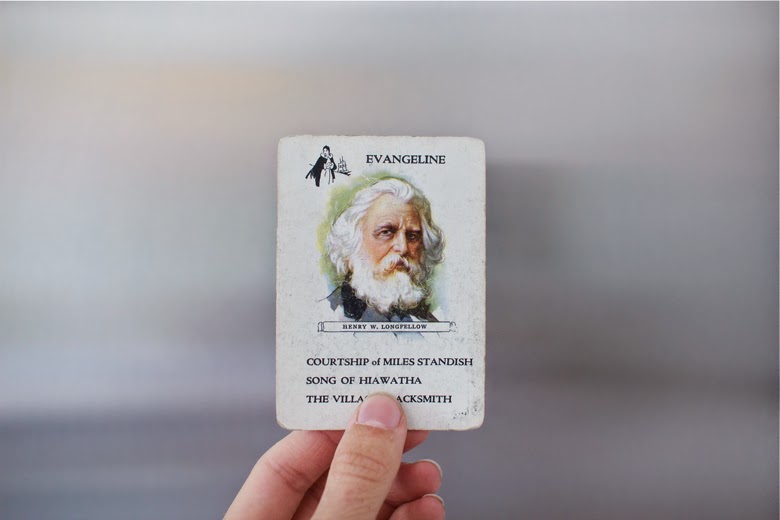As a child, a number of games appeared in our
family life, brought to us by my grandmother, the very ones played by my mother
when she was a child in the 1940s. These included such enduring classics as
vintage Monopoly and Parcheesi boards. Also included was a card game called
Authors, popular in the U.S.A. (where my mother grew up), yet all but unknown
in Canada. It was meant to be educationally exemplary, an Old Maid-variant
devised in the 1860s wherein a great figure of literature (with a decidedly
American slant) were portrayed along with four of his (or her, the lone female
being Louisa May Alcott) most well known titles. The goal, of course, was to
extract cards by a particular author from your opponents and notch up a complete
set of four to your “library.” In addition to concentration on the game, there
were aesthetic pleasures to the cards in your hand, the soft-style period
illustration bust portraits, small-print identification on a banner across the
author’s chest and silhouette vignettes in the top left corner that
encapsulated each title with an image.
As a result of numerous days spent with Authors,
I formed lasting ideas about literature, which I did not bother to examine further by actually reading any of these books. A stereotypical boy, I
suppose, my preference was to gather titles of adventure writers like Robert
Louis Stevenson, James Fenimore Cooper and Mark Twain, with William Shakespeare
thrown in for good measure, an acknowledgment of the local proximity of the
Stratford Festival. What readings of the “classics” I did in my youth were almost strictly via Classics Illustrated
comic books, choices of which never intersected with the “literacy” that I
acquired by playing Authors.
Last month, at the St. Lawrence Antique Market,
I found a more recent deck of Authors, dating, I would guess, from the late
50s. Only a few of the authors represented were the same—Alcott, Stevenson,
Twain and Charles Dickens —their portraits, while derivative of those in the
earlier set, were, to my eye, cruder, and the titles selected to represent them
were different. Light blue replaced the black print. Instead of individual
silhouettes for each title, a generic line drawing was repeated four times for
every author. The new names included Howard Pyle, A.A. Milne, Hans Christian
Anderson and Rudyard Kipling. Louisa Alcott was no longer the lone woman, the
new set adding Cornelia Meigs (completely unknown to me). Someone had been
inspired to bring children’s literature to a child’s game. However, there is
something disconcerting about the probably all-too-accurate portraits of the
adult authors, typically stern or sallow countenances. Even to a grown-up me,
their faces trigger shuddering memories of fearsome Grade Four teachers and
school principals.
Guest contributor Ben Portis












No comments:
Post a Comment